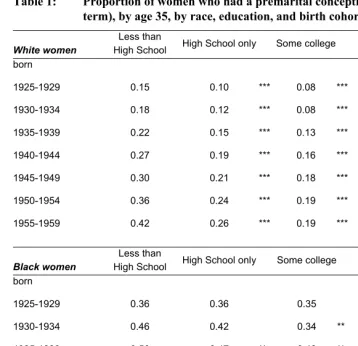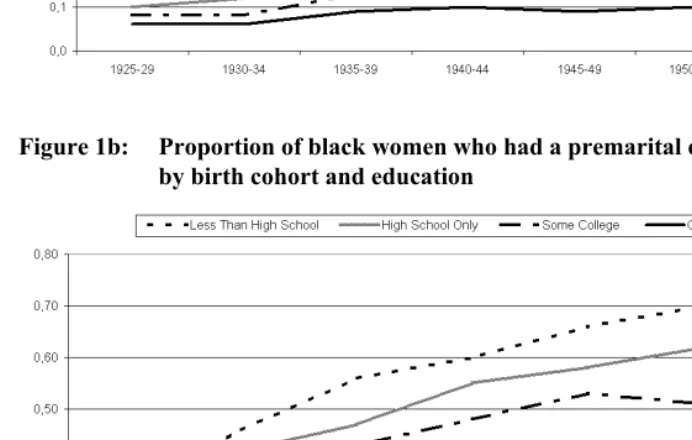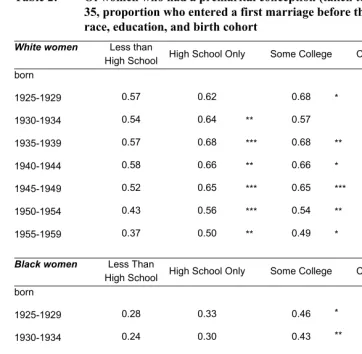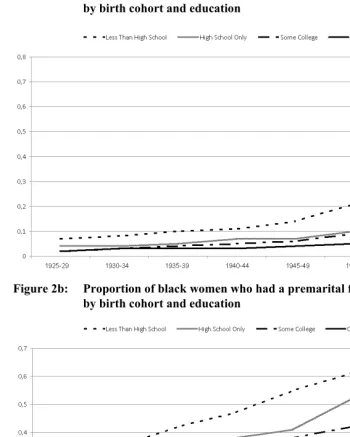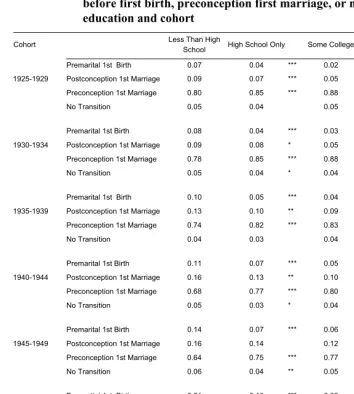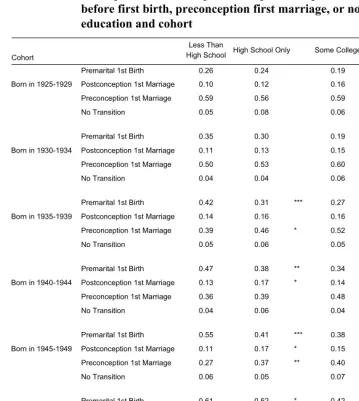in the population sciences published by the Max Planck Institute for Demographic Research Konrad-Zuse Str. 1, D-18057 Rostock · GERMANY www.demographic-research.org
DEMOGRAPHIC RESEARCH
VOLUME 27, ARTICLE 6, PAGES 153-166
PUBLISHED 25 JULY 2012
http://www.demographic-research.org/Volumes/Vol27/6/ DOI: 10.4054/DemRes.2012.27.6
Descriptive Finding
Premarital conceptions, postconception
(“shotgun”) marriages, and premarital first
births: Education gradients in U.S. cohorts of
white and black women born 1925-1959
Paula England
Emily Fitzgibbons Shafer
Lawrence L. Wu
© 2012 England, Shafer & Wu.
This open-access work is published under the terms of the Creative Commons Attribution NonCommercial License 2.0 Germany, which permits use, reproduction & distribution in any medium for non-commercial purposes, provided the original author(s) and source are given credit.
1 Introduction 154
2 Data and methods 154
3 Results 156
3.1 Education differences in premarital conceptions 156 3.2 Education differences in postconception marriages 159 3.3 Education differences in premarital first births 161
4 Discussion and conclusion 165
Premarital conceptions, postconception (“shotgun”) marriages, and
premarital first births: Education gradients in U.S. cohorts of white
and black women born 1925-1959
Paula England1
Emily Fitzgibbons Shafer2
Lawrence L. Wu3
Abstract
BACKGROUND
In the U.S. today, premarital first births occur disproportionately to women with low education and income. We lack studies of whether this education gradient was present in cohorts born earlier.
OBJECTIVE
We examine education differences in the proportion of U.S. white and black women who: (a) experienced a premarital conception taken to term resulting in a first birth, and (b) had a premarital first birth by age 35. Among those experiencing a premarital conception, we examine the association between education and whether women married before the birth. We examine these patterns for birth cohorts born between 1925 and 1959.
METHODS
We use the 1980, 1985, 1990, and 1995 June Fertility Supplements from the U.S. Current Population Survey to examine cohorts of women born between 1925 and 1959. The survey asked women the dates of their first marriage and their first birth, allowing us to determine premarital conceptions taken to term, and whether the resulting first births occurred within or outside of first marriage. We present descriptive information on the proportion of black and white women in each cohort who experienced the events of interest by age 35.
1 New York University. 2 Harvard University.
3 New York University. Research funding from NICHD (HD 29550 to Lawrence L. Wu) is gratefully
RESULTS
For all cohorts, women with low education were generally more likely than their more educated counterparts to experience premarital conceptions and premarital first births. For blacks, but not whites, who experienced a premarital conception that was taken to term, those with more education were more likely to marry before the birth.
CONCLUSIONS
In the U.S., the concentration of premarital conceptions and premarital first births among less educated women was present for cohorts extending back to those born in 1925.
1. Introduction
It is well known that, in the U.S., nonmarital births have increased for both whites and blacks (Bachu 1999; Wu 2008; Ventura 2009), and that, in recent decades, women who have nonmarital births are disproportionately of low education and income (Upchurch et al. 2002; Ellwood and Jencks 2004). This paper examines whether the relationship between education and having a premarital conception or first birth existed for earlier U.S. birth cohorts.
2. Data and methods
We pool data from the retrospective marital and fertility histories from the June 1980, 1985, 1990, and 1995 U.S. Current Population Surveys (CPS). These June CPS fertility and marital supplements were administered to married women aged 15 or older and never-married women aged 18 or older. We use these data to identify the date (to the nearest month) of first births and first marriages. We assume that all conceptions occurred nine months prior to the birth, and employ a definition of a premaritally conceived but postmarital first birth as a first birth occurring less than seven months after a first marriage.4 This in effect assumes that first births that occur seven or eight
months after a first marriage are premature births conceived within marriage. This
4 In results, not shown, we changed the definition of postconception marriages to be those in which the birth
procedure clearly introduces some classification errors, but provides a standard operational definition of a premarital conception for those conceptions taken to term.
Because these data contain no information on pregnancies ending in miscarriage or abortion, our analyses are limited to conceptions taken to term. A further limitation of these data is that they lack information on cohabitation. However, the vast majority of premarital conceptions taken to term and resulting in a first birth to women born between 1925 and 1959 occurred in periods when abortion and cohabitation were relatively uncommon.
Unweighted estimates are presented throughout. We limit our analysis to first marriages and first births. For the birth cohorts we examine, about three out of four premarital conceptions taken to term involved first births, and about nine out of ten marriages occurring between a premarital conception and a first birth were first marriages (results not shown).
Our key independent variable is education. Respondents were asked how many years of education they had completed, and our analyses contrast results for four groups: Less than High School (11 or fewer years of education completed), High School Graduates (12), Some College (13-15), and College Graduates (16 or more).
The major limitation of our analysis is that, while we would like to treat women’s reported education as exogenous to conceptions or marriage, the CPS education variable in fact refers to years of schooling completed at the time of CPS survey, and hence after marriages, conceptions, and births have occurred—sometimes decades later. Particularly problematic is the possibility that premarital conceptions or births interrupted young women’s education, causing them to fail to complete as many years of high school or college as they otherwise would have. If this were the case, we could observe education ‘predicting’ premarital conceptions and births, when in fact it was the conceptions and births that interrupted education.5
Given this, our results should be interpreted as providing estimated associations rather than causal estimates of educational gradients. We believe, however, that some of the association we estimate is likely to be causal, as recent longitudinal research shows more support for the effect of education on premarital or teen births than vice versa. (See Upchurch et al. [2002], who use simultaneous hazards equations; Geronimus and Korenman [1991] and Hoffman et al. [1993] who use sibling fixed effects; and Stange [2011] who shows that the educational trajectories of women diverge well before a birth.)
We divide women by birth cohort, arraying descriptive statistics separately for cohorts born in 1925-29, 1930-34, 1935-39, 1940-44, 1945-49, 1950-54, and 1955-59.
5 Other potential biases exist. For example, to the extent that premarital conceptions are stigmatized, women
For whites, the average age at a premarital first birth was 19 or 20 for all cohorts; for Blacks it was 19 for all cohorts (results not shown). The premarital first births in the cohorts we consider thus occurred from approximately the 1940s to the late 1970s.
3. Results
3.1 Education differences in premarital conceptions
Table 1 shows that the proportion of women experiencing a premarital conception taken to term has a strong association with education. For the most recent cohort of women born 1955-59, premarital conceptions occurred to .09 of white college graduates and to .42 of white women who did not graduate from high school. In the earliest cohort of women born 1925-29, levels for all groups were lower and the education differential was not as great, but the analogous proportions were .06 for white college graduates and .15 for white women with less than a high school degree. All other cohorts also had a monotonic education gradient, with higher proportions of premarital conception at lower educational levels, as is visually apparent in Figure 1a.
Table 1: Proportion of women who had a premarital conception (taken to term), by age 35, by race, education, and birth cohort
White women
Less than
High School High School only Some college College degree born
1925-1929 0.15 0.10 *** 0.08 *** 0.06 ***
1930-1934 0.18 0.12 *** 0.08 *** 0.06 ***
1935-1939 0.22 0.15 *** 0.13 *** 0.09 ***
1940-1944 0.27 0.19 *** 0.16 *** 0.10 ***
1945-1949 0.30 0.21 *** 0.18 *** 0.09 ***
1950-1954 0.36 0.24 *** 0.19 *** 0.10 ***
1955-1959 0.42 0.26 *** 0.19 *** 0.09 ***
Black women
Less than
High School High School only Some college College degree
born
1925-1929 0.36 0.36 0.35 0.34
1930-1934 0.46 0.42 0.34 ** 0.23 ***
1935-1939 0.56 0.47 ** 0.43 ** 0.24 ***
1940-1944 0.60 0.55 0.48 ** 0.29 ***
1945-1949 0.66 0.58 * 0.53 *** 0.36 ***
1950-1954 0.70 0.62 * 0.51 *** 0.31 ***
1955-1959 0.66 0.70 0.63 0.36 ***
Figure 1a: Proportion of white women who had a premarital conception, by birth cohort and education
3.2 Education differences in postconception marriages
Any association between education and having a premarital first birth can be driven by the association between education and premarital conceptions or by the association of education with whether a conception resulted in what is colloquially called a “shotgun” marriage, which we refer to as a postconception marriage. Thus, we next consider the association between education and marrying between a premarital conception and first birth, conditional on taking a premarital conception to term. Of those who conceived before a first marriage, the proportion of whites entering a first marriage before the birth did not vary dramatically by education within cohort, but generally had an inverted U-shape (Table 2). The least educated were the least likely to marry between a premarital conception and a birth, and those with intermediate levels of education had the highest rates of marrying following a premarital conception but before the birth.
In contrast, for blacks the relationship between education and marrying before the birth is, with few exceptions, positive and monotonic in every cohort; the higher the education of black women who were premaritally pregnant, the more likely they were to marry between the conception and the birth (Table 2). For all but two cohorts the difference between the proportions for the least and highest educated groups are statistically significant.
Another way of looking at postconception first marriages is to ask what proportion of all women experienced one by age 35. Table 3a shows that for white women, if we compare within cohort, the lower a woman’s education, the more likely she is to enter a first marriage between a premarital conception and the first birth. (See the row titled “Postconception First Marriage.”) This result is driven primarily by the white education gradient on premarital conceptions. For black women there is no clear education gradient in the percentage of all women having a postconception first marriage, because those with more education have fewer premarital conceptions but, conditional on such conceptions, have higher rates of marrying before the birth.6
6In results not shown, we examine what proportion of women’s first marriages (before age 35) were between a
premarital conception and the first birth, which can be calculated from Table 3 as the proportion that those experiencing a postconception first marriage by age 35 constitute of those who experienced either a
Table 2: Of women who had a premarital conception (taken to term) by age 35, proportion who entered a first marriage before the first birth, by race, education, and birth cohort
White women Less than
High School High School Only Some College College Degree
born
1925-1929 0.57 0.62 0.68 * 0.64
1930-1934 0.54 0.64 ** 0.57 0.58
1935-1939 0.57 0.68 *** 0.68 ** 0.60
1940-1944 0.58 0.66 ** 0.66 * 0.65 *
1945-1949 0.52 0.65 *** 0.65 *** 0.57
1950-1954 0.43 0.56 *** 0.54 ** 0.51
1955-1959 0.37 0.50 ** 0.49 * 0.44
Black women Less Than
High School High School Only Some College College Degree
born
1925-1929 0.28 0.33 0.46 * 0.53 *
1930-1934 0.24 0.30 0.43 ** 0.45 *
1935-1939 0.25 0.34 * 0.37 * 0.37
1940-1944 0.21 0.31 ** 0.29 0.47 ***
1945-1949 0.17 0.30 *** 0.28 * 0.40 ***
1950-1954 0.13 0.15 0.19 0.26 *
1955-1959 0.02 0.09 0.11 * 0.08
3.3 Education differences in premarital first births
Figure 2a: Proportion of white women who had a premarital first birth, by birth cohort and education
Table 3a: Proportion of white women by age 35 who had a premarital first birth, premarital conception with postconceptionfirst marriage before first birth, preconception first marriage, or no transition, by education and cohort
Cohort Less Than High
School High School Only Some College College Degree
Premarital 1st Birth 0.07 0.04 *** 0.02 *** 0.02 ***
1925-1929 Postconception 1st Marriage 0.09 0.07 *** 0.05 *** 0.04 ***
Preconception 1st Marriage 0.80 0.85 *** 0.88 *** 0.83 *
No Transition 0.05 0.04 0.05 0.11 ***
Premarital 1st Birth 0.08 0.04 *** 0.03 *** 0.03 ***
1930-1934 Postconception 1st Marriage 0.09 0.08 * 0.05 *** 0.04 ***
Preconception 1st Marriage 0.78 0.85 *** 0.88 *** 0.83 ***
No Transition 0.05 0.04 * 0.04 0.11 ***
Premarital 1st Birth 0.10 0.05 *** 0.04 *** 0.03 ***
1935-1939 Postconception 1st Marriage 0.13 0.10 ** 0.09 *** 0.05 ***
Preconception 1st Marriage 0.74 0.82 *** 0.83 *** 0.82 ***
No Transition 0.04 0.03 0.04 0.10 ***
Premarital 1st Birth 0.11 0.07 *** 0.05 *** 0.03 ***
1940-1944 Postconception 1st Marriage 0.16 0.13 ** 0.10 *** 0.06 ***
Preconception 1st Marriage 0.68 0.77 *** 0.80 *** 0.81 ***
No Transition 0.05 0.03 * 0.04 0.10 ***
Premarital 1st Birth 0.14 0.07 *** 0.06 *** 0.04 ***
1945-1949 Postconception 1st Marriage 0.16 0.14 0.12 ** 0.05 ***
Preconception 1st Marriage 0.64 0.75 *** 0.77 *** 0.78 ***
No Transition 0.06 0.04 ** 0.05 0.13 ***
Premarital 1st Birth 0.21 0.10 *** 0.09 *** 0.05 ***
1950-1954 Postconception 1st Marriage 0.15 0.13 0.10 *** 0.05 ***
Preconception 1st Marriage 0.58 0.71 *** 0.75 *** 0.77 ***
No Transition 0.06 0.05 0.06 0.13 ***
Premarital 1st Birth 0.27 0.13 *** 0.10 *** 0.05 ***
1955-1959 Postconception 1st Marriage 0.16 0.13 0.09 ** 0.04 ***
Preconception 1st Marriage 0.51 0.67 *** 0.72 *** 0.77 ***
No Transition 0.06 0.07 0.08 0.14 ***
Table 3b: Proportion of black women by age 35 who had a premarital first birth, premarital conception with postconception first marriage before first birth, preconception first marriage, or no transition, by education and cohort
Cohort
Less Than
High School High School Only Some College College Degree
Premarital 1st Birth 0.26 0.24 0.19 0.16
Born in 1925-1929 Postconception 1st Marriage 0.10 0.12 0.16 0.18 *
Preconception 1st Marriage 0.59 0.56 0.59 0.60
No Transition 0.05 0.08 0.06 0.06
Premarital 1st Birth 0.35 0.30 0.19 *** 0.13 ***
Born in 1930-1934 Postconception 1st Marriage 0.11 0.13 0.15 0.10
Preconception 1st Marriage 0.50 0.53 0.60 * 0.70 ***
No Transition 0.04 0.04 0.06 0.07
Premarital 1st Birth 0.42 0.31 *** 0.27 *** 0.15 ***
Born in 1935-1939 Postconception 1st Marriage 0.14 0.16 0.16 0.09
Preconception 1st Marriage 0.39 0.46 * 0.52 ** 0.67 ***
No Transition 0.05 0.06 0.05 0.08
Premarital 1st Birth 0.47 0.38 ** 0.34 *** 0.15 ***
Born in 1940-1944 Postconception 1st Marriage 0.13 0.17 * 0.14 0.14
Preconception 1st Marriage 0.36 0.39 0.48 ** 0.64 ***
No Transition 0.04 0.06 0.04 0.07
Premarital 1st Birth 0.55 0.41 *** 0.38 *** 0.22 ***
Born in 1945-1949 Postconception 1st Marriage 0.11 0.17 * 0.15 0.14
Preconception 1st Marriage 0.27 0.37 ** 0.40 *** 0.52 ***
No Transition 0.06 0.05 0.07 0.12 *
Premarital 1st Birth 0.61 0.52 * 0.42 *** 0.23 ***
Born in 1950-1954 Postconception 1st Marriage 0.09 0.09 0.10 0.08
Preconception 1st Marriage 0.25 0.32 0.39 ** 0.55 ***
No Transition 0.05 0.06 0.10 0.14 **
Premarital 1st Birth 0.65 0.63 0.56 0.33 ***
Born in 1955-1959 Postconception 1st Marriage 0.01 0.06 0.07 * 0.03
Preconception 1st Marriage 0.27 0.24 0.29 0.42 *
No Transition 0.07 0.06 0.08 0.22 *
4. Discussion and conclusion
We documented persistent educational gradients in premarital conceptions and premarital first births for birth cohorts of white and black women. With respect to premarital conceptions (taken to term), as far back as birth cohorts born in 1925-29 for whites, and 1930-34 for blacks, more educated women had lower probabilities of having a premarital conception than did women with less education.
We documented educational gradients in postconception first marriage for black but not white women. For all cohorts of black women who experienced a premarital conception taken to term and resulting in a first birth, those with more education were more likely to enter a first marriage before the birth. For whites experiencing such a premarital conception, women with intermediate levels of education were slightly more likely to marry between a premarital conception and a birth than were women with either the highest or lowest level of education.
References
Bachu, A. (1999). Trends in Premarital Childbearing: 1930-1994. Washington, D.C.: U.S. Bureau of the Census.
Ellwood, D.T. and Jencks, C. (2004). The Uneven Spread of Single-Parent Families: What Do We Know? In: Neckerman, K.M. (ed.). Social Inequality. New York: Russell Sage Foundation: 3–78.
Geronimus, A.T. and Korenman, S. (1991). The socioeconomic consequences of teen childbearing reconsidered. Quarterly Journal of Economics 107: 1187-1214.
http://dx.doi.org/10.2307/2118385.
Hoffman, S.D., Foster, E.M., and Furstenberg, F.F. (1993). Reevaluation the costs of teenage childbearing. Demography 30:1-13.http://dx.doi.org/10.2307/2061859. Stange, K. (2011). A Longitudinal Analysis of the Relationship Between Fertility
Timing and Schooling. Demography 48: 931-956. http://dx.doi.org/10.1007/ s13524-011-0050-3.
Upchurch, D.M., Lillard, L.A., and Panis, C.W.A. (2002). Nonmarital Childbearing: Influences of Education, Marriage, and Fertility. Demography 39(2): 311-329.
http://dx.doi.org/10.1353/dem.2002.0020.
Ventura, S.J. (2009). Changing patterns of nonmarital childbearing in the United States. NCHS data brief, no 18. Hyattsville, MD: National Center for Health Statistics. Wu, L.L. (2008). Cohort Estimates of Nonmarital Fertility. Demography 45(1):
